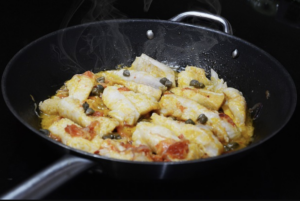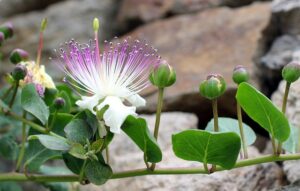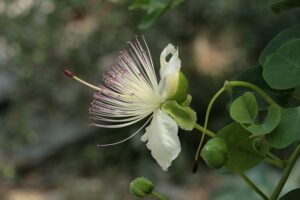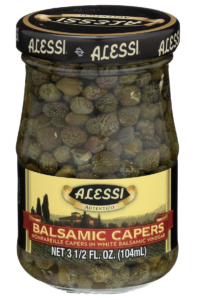Capers add a lemony-briny flavor to dishes used often in Mediterranean cuisine, like seafood dishes and pasta sauces such as puttanesca sauce. They add a briny, savory, lemony taste to poultry dishes like chicken piccata.
Capers get harvested before the green bud blooms into a flower, picked at different sizes. According to many sources, they are available in six different sizes.
- Nonpareilles: About 7 milliliters in diameter (approximately ¼ inch)
- Surfines: 7 to 8 millimeters
- Capucines: 8 to 9 millimeters
- Capotes: 9 to 11 millimeters
- Fines: 11 to 13 millimeters
- Grusas: Over 14 millimeters
The size of a caper can influence the taste. Large capers offer a more robust taste, while small ones are more delicate in flavor. Capers get preserved using salt or in a brine. The method used distinguishes a caper’s taste.
Growing Tips
Growing capers (Capparis spinosa) can be a rewarding endeavor, but it’s important to note that caper plants require specific growing conditions and care.
Capers thrive in hot, arid climates and require plenty of direct sunlight at least 6 to 8 hours a day. Choose a location of sandy or rocky soil to prevent root rot. The caper plant needs good drainage to grow.
Cover the caper plants in winter months with straw or burlap, and bring them indoors if possible to help prevent frost.
Capers are slow to sprout from seeds, and using cuttings can speed up the early growth process.
Cut 6-8 inch pieces from a mature caper plant in late winter or early spring, and plant about 2 inches deep and space the plants at least 3 feet apart.
During the first year of growth, a caper bush needs regular watering. After the first year, reduce watering to keep the soil consistently moist but not over-watered. Caper plants are drought-tolerant once fully grown.
Avoid high-nitrogen fertilizers, as they can encourage excessive foliage growth at the expense of caper production.
In late winter or early spring, prune before new growth starts. Pruning encourages bushy growth to help grow more capers faster.
It will take several years before a caper plant starts producing abundant buds.
Packaging capers in white balsamic vinegar is a creative way to enhance their flavor and preserve their quality. The combination of capers and white balsamic vinegar can add a new dimension of taste to your culinary creations, making them even more appealing and delicious.
Capers have certainly earned their place in gastronomy, and their unique flavor profile continues to make them a favorite ingredient in kitchens around the world.
Capers are used to enhance the taste and texture of a wide range of dishes, including salads, pasta, sauces, and meat or fish dishes. They can be enjoyed both as a garnish and as a primary ingredient in recipes, contributing their distinctive flavor to the culinary world. The briny and slightly sour taste of capers pairs well with many ingredients and can add a delightful complexity to a variety of dishes.





